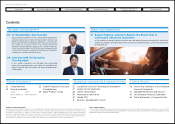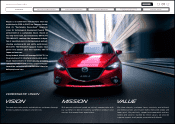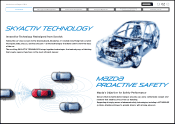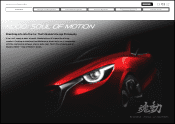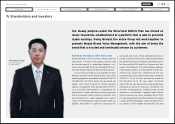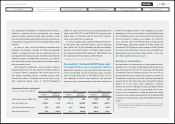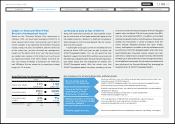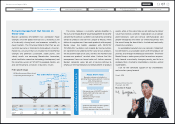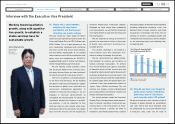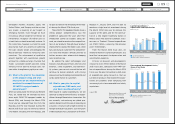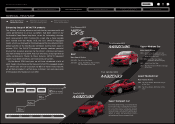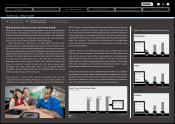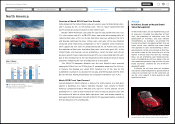Mazda 2014 Annual Report Download - page 11
Download and view the complete annual report
Please find page 11 of the 2014 Mazda annual report below. You can navigate through the pages in the report by either clicking on the pages listed below, or by using the keyword search tool below to find specific information within the annual report.
developed markets including Japan, the
United States, and Europe, and the revision
was mainly a lowering of our targets in
emerging markets. Even though we have
revised our official target to 1.52 million, we
nevertheless recognize 1.70 million units as
a level that we should eventually achieve. At
the same time, however, we need to avoid
placing too much of a priority on achieving
the sales volume target and damaging the
Mazda brand by recklessly increasing sales
incentives. The achievement of qualitative
growth together with quantitative growth
will lead to a stable earnings structure that
makes sustainable growth possible. Going
forward, we will work to increase sales vol-
ume while strengthening right-price sales.
Q3. What is the plan for the expansion
of the product lineup and what
measures are you implementing to
maintain the competitiveness of
SKYACTIV-equipped models
going forward?
When we announced the Structural Reform
Plan, we stated that we intended to intro-
duce eight SKYACTIV-equipped models by
March 2016, and through the March 2014
fiscal year we released three: the CX-5, the
Mazda6, and the new Mazda3. During the
March 2015 fiscal year, we intend to release
two models including the new Mazda2, and
we plan to release the remaining three mod-
els during the March 2016 fiscal year.
These SKYACTIV-equipped models have a
strong product competitiveness, but the
problem of aging over the years after their
introduction cannot be avoided. Going for-
ward, we intend to maintain the competitive-
ness of our products through major product
improvements during the model cycle, while
fully conveying to customers the comprehen-
sive value that Mazda’s vehicles provide, to
further increase sales volume while keeping
sales incentives low.
By adding the latest technologies and
features, including powertrains, interiors and
exteriors, safety equipment, and connectiv-
ity systems, you can rest assured that we will
continue to deliver products with
driving
pleasure
and
outstanding environmental and
safety performance to customers
.
Q4. What is your plan for capital
expenditures, R&D costs, and
your basic investment policy?
With regard to capital expenditures, we will
continue to improve the efficiency of expen-
ditures through Monotsukuri Innovation. We
are currently restructuring our global pro-
duction footprint with the aim of migrating to
a business structure with a high resilience to
foreign exchange fluctuations. Our new plant
in Mexico began mass production of the new
Mazda3 in January 2014, and we plan to
maintain a high level of investment during
the March 2015 fiscal year to increase the
capacity of this plant, and for the construc-
tion of a new engine machining factory in
Mexico and a new plant for automatic trans-
missions in Thailand. Planned expenditures
are ¥150.0 billion, surpassing the previous
year’s ¥133.2 billion.
From the March 2016 fiscal year, we
intend to maintain capital expenditures at a
level that corresponds to depreciation and
amortization expenses.
In terms of research and development,
we plan to invest ¥100.0 billion in the March
2015 fiscal year, compared with ¥99.4 bil-
lion of expenditures during the March 2014
fiscal year. We plan to maintain a high level
of expenditures going forward so that we
can deliver products that exceed the expec-
tations of customers while complying with
increasingly strict environmental and safety
regulations.
August 2014 Representative Director and
Executive Vice President
Akira Marumoto
Capital Expenditures /
Depreciation and Amortization
Billions of yen
29.8
76.4
44.7
71.6 78.068.8 77.2
60.0 57.7
133.2
2010 2011 2012 2013 2014
Capital Expenditures
Depreciation and Amortization
(Years ended March 31)
85.2 91.0 91.7 89.9
99.4
3.9 3.9 4.5
4.1
3.7
Research and Development Costs /
Share of Net Sales
Billions of yen / %
2010 2011 2012 2013 2014
Research and Development Costs
Share of Net Sales
(Years ended March 31)
09
Mazda Annual Report 2014
CONTENTS
Message from Management
Introduction
Brand Value Management
Review of Operations
Foundations Underpinning
Sustainable Growth
Financial Section


